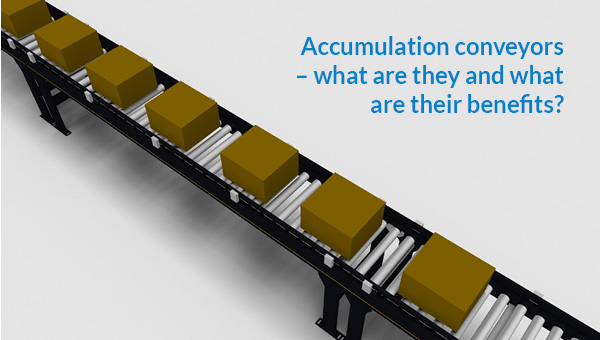Accumulation conveyors are used to temporarily stop, hold and release items on a conveyor. They are commonly used by manufacturers and warehouses that wish to maximise productivity and throughput.
With various types of accumulation conveyors on the market, in this blog we aim to explain the differences, describe how they work and identify their benefits.
There are two main types of accumulation conveyors: minimum pressure conveyors and zero-pressure conveyors (also known as zero-line pressure conveyors, or ZLP conveyors).
Minimum pressure accumulation conveyors
A minimum pressure accumulation conveyor continuously drives loads forward. Loads are stopped or held back using a physical stop e.g a roller brake or brake belt. As the loads accumulate and back-up they come into contact with each other.
When the conveyor stops a moving item, back pressure is kept to a minimum, usually 2%, to help ensure that the pressure of the upstream boxes does not crush the first package in the row.
When the physical stop mechanism is removed, the boxes will be released with the same pressure as they were being held. The boxes can be discharged one-by-one, altogether, or in batches, by introducing and removing the physical stop mechanism.
Minimum pressure conveyors, whilst very cost efficient should only be used with boxes of similar sizes and weights and on short lines of conveyor. This is to prevent damage when the items come into contact with each other.
Zero pressure accumulation conveyors
Zero pressure conveyors have an automatic start/stop functionality, for optimum product control. Cartons are stopped with a small buffering space between them so they never touch.
Early versions of zero pressure conveyors used pressure sensor rollers divided into zones and mechanically linked to start or stop the conveyor section, based on the pressure detected. Whilst fairly effective, conveying very light products proved problematic as the pressure sensor roller didn’t depress, in addition, springs and linkages wore over time.
Today, ZLP conveyors use photo-sensors to detect when products are present on the line.
How do ZLP accumulation conveyors work?
- The conveyor is fitted with motorised driving rollers along its length, enabling loads to be automatically controlled in ‘zero pressure zones’.
- Photocells are fitted adjacent to each motor which send information to the onboard ASI control system. This automatically controls the stop / start action of the motors.
- As the loads are conveyed along the conveyor, the photocells inform the control system that product is present.
- The control unit then checks if the forward zone is unoccupied.
- If the zone is clear, the downstream motor starts, enabling the product to be passed forward where the action is repeated.
- If the downstream zone is occupied then the control system stops the motor immediately until it is clear.
The benefits of accumulation conveyors
Buffering
Production and warehouse processes can take different amounts of time. And, if downstream processes take longer than upstream processes, this can cause line congestion, product back-ups and workforce stoppages. Accumulation conveyors buffer the flow and regulate work imbalances between upstream and downstream operations, for instance between picking and packing.
Maximise product throughput
Because accumulation conveyors allow a steady flow of products both up and downstream processes can remain continuous and no equipment (or people) have to sit idly. This means increased production and lower labour costs.
Additional benefits with zero line pressure conveyors:
Prevent product damage
When products stack-up on a traditional conveyor this can cause damage, particularly to fragile or lighter cartons. Accumulation conveyors allow products to either rest against each other (minimum pressure conveyors) or line-up with a small gap between them (zero pressure conveyors), reducing product damage, waste and costs.
Reduce equipment wear and tear
When items back-up on a conveyor they can often create so much back pressure that over time they will damage the guardrails, belts, motors, reducers and motor starters. Zero pressure conveyors will help slow down the wear and tear of this equipment.
Energy saving
The ‘sleep’ feature of ZLP conveyors makes them an ideal choice when energy efficiency is important, as they will reduce electricity consumption and energy costs.
When do you use accumulation conveyors?
Accumulation conveyors can be used to:
- Act as a buffer between processes, to ensure a steady production flow.
- Efficiently queue boxes or cartons to feed a sorting, wrapping, strapping, palletizing, or other process.
- Convey fragile and light products – especially important when the conveyor speed and throughput increase.
- On inclines, declines, and spirals to gain additional accumulation linear footage.
Accumulation conveyors can be installed within your existing system or integrated in other Keymas products or a total systems solution.
For more information please contact us here, we’ll be happy to carry out a free site visit.
Keymas are a conveyor systems and automation company. Contact us today to find out how we can help automate your business
Contact Us

